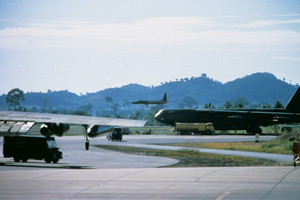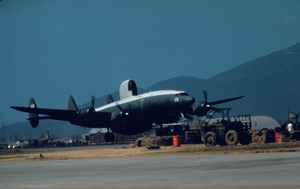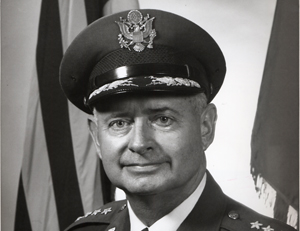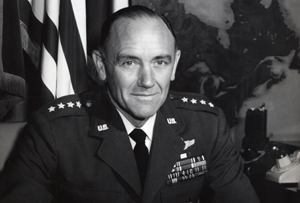In spring 1952, the Air Force established a listening operation on the island of Cho-do, off the east coast of Korea. The mission at Cho-do was the monitoring of Chinese, North Korean, and Russian communications. The site, staffed with teams of linguists and tactical air control center personnel, gave US air crews almost real-time information as they prepared for battle over North Korea.
This timely intelligence contributed much to the American ability to dominate “MiG Alley,” for it informed pilots of the best opportunities to engage enemy forces, given the handicaps of distant basing and limited fuel supply.
 |
A U-2 and B-52s at U Tapao AB, Thailand. |
Despite the success from feeding signals intelligence directly to the combat pilots, the system withered after the war. As a result, the US had to reinvent the wheel during the Vietnam War while also dealing with new bureaucratic roadblocks. It wasn’t until July 26, 1972 that intelligence specialists, using the call sign “Teaball,” began operations with a system comparable to that used in the Korean War a generation earlier. It provided something close to a composite air picture.
In Vietnam, US airborne assets were used for specific intelligence needs, but airmen for many years overlooked the desirability of getting current information directly to pilots engaged in a mission. Old airframes and new equipment were blended together for the task. Still, the intelligence was so guarded, channeled, and compartmentalized that little of it reached aircrews in flight over enemy territory. This would contribute to the long years of frustration for US fighter forces over Vietnam as the lack of real-time intelligence about enemy aircraft compounded the myriad other handicaps the airmen dealt with.
The frustrations in dealing with enemy fighters mounted steadily throughout the war. In early 1972, Gen. John W. Vogt, head of USAF’s 7th Air Force, said the Air Force was actually losing the air war.
During the period between US involvement in the Korean and Vietnam Wars, however, there was remarkable progress in the science of electronic warfare, especially for use by airborne platforms. An emphasis on getting intel into USAF’s fighter cockpits, led by the highly classified Project Teaball, helped to turn the tide in the war’s waning days. Combining the evolving technology with political will was a difficult task.
New and more versatile equipment appeared continually, expanding America’s theoretical capability to listen in on enemy communications, locate and pinpoint radar installations, and learn the characteristics of enemy systems. US contractors developed entire arrays of specialized equipment and aircraft, designed specifically to obtain varied forms of electronic intelligence.
Green Door Barriers
Dedicated crews often elicited more from their equipment than had been anticipated by designers. But this progress was masked by a growing bureaucracy and a welter of security barriers. These were the familiar “green doors” and “stovepipes” that compartmentalized the data yield and prevented its full exploitation for most of the Vietnam War.
 |
An EC-121M takes off from Da Nang AB, South Vietnam, for a mission over the Gulf of Tonkin. |
The Sigint—or signals intelligence—side of the Vietnam War was characterized by a serial and overlapping addition of electronic signal interpretation techniques that were not well-integrated. Further complicating the situation, American advances in elaborate electronic intelligence equipment and techniques were matched by a parallel growth of stifling bureaucracy. A focus on genuine security concerns set limits on the distribution of vital information to the people who needed it most—US combat pilots flying over Vietnam.
The United States, faced with a new North Vietnamese regular offensive in spring 1972, resumed bombing operations in North Vietnam on May 10, 1972. During the next 80 days, the US lost 48 aircraft, 21 to MiG fighters and 27 to surface-to-air missiles and anti-aircraft fire. During the same period, US pilots succeeded in shooting down only 31 MiGs. Two major factors were the effectiveness of ground-controlled North Vietnamese pilots and the lack of American radar warning to pilots about to be attacked.
In June and July, the North Vietnamese Air Force shot down 13 US aircraft in aerial combat while losing just 11. The tiny North Vietnamese Air Force was allowing its pilots to become ever more efficient in its preferred tactic: use of a single high-speed pass from the rear, capped by the launch of an Atoll missile.
At the same time, the Air Force was repeatedly giving up its combat proficiency. The service’s rotational policy continuously pushed out veteran pilots and brought in less-experienced pilots for their first combat tours. Before the era of Red Flag combat training, it was these initial missions against live enemies that cost the US most of its pilots. They were forced to learn on the job—or die trying.
The situation was made all the worse by the broadcast of intelligence using the “Bull’s Eye System.” This technique harkened back to the earliest airborne artillery registration tactics of World War I, simple signals indicating “long” or “short” and later amplified by clock code signals. It was used to give pilots vector and distance information via a “bull’s-eye” drawn around the target. It was inaccurate, especially for single-pass missions.
Vogt knew the pilots’ lack of access, via their radios, to real-time information left them vulnerable. He informed USAF Chief of Staff Gen. John D. Ryan of the problem, and Ryan reacted immediately to Vogt’s concerns. He told his Air Staff that he wanted action—not a plan, and not a study, but action. Ryan established a three-man action group consisting of Lt. Col. William L. Kirk, Maj. Ernie Short, and Delmar Lang (representing the National Security Agency, or NSA).
Lang had previously volunteered to replicate the Cho-do setup in Vietnam, but had been repeatedly refused. As a result, the team was not surprised when their efforts, although mandated by the Chief of Staff, were initially turned down by some at 7th Air Force because of opposition to giving “raw data” to aircrews.
 |
An RC-135 prepares to refuel over Southeast Asia. At left: Feeding data into the Teaball system were a variety of sensor platforms, including RC-135M Combat Apple aircraft. Combat Apple preceded Teaball and completed its 1,000th mission in 1969. |
NKP Operation
Finally, with Vogt’s support, the objections were overridden. Kirk and his team moved to Nakhon Phanom AB, Thailand—also known as NKP. There, working with the 6908th Security Squadron, they could tap into the network of radios monitoring North Vietnamese air operations. They established a control van where map displays could chart the air battle and where the necessary command and control equipment was readily available.
RC-135C (Burning Pipe) and RC-135M (Combat Apple) aircraft orbited over the Gulf of Tonkin and Laos, gathering communication and electronics intelligence. The ubiquitous U-2 soared high above the RC-135s, receiving their transmissions and then resending the data to Teaball’s operation room at NKP.
At NKP, these freshly collected Sigint data were then combined with ground-based radar data as well as with the radar data gathered by EC-121s. These aircraft had all been intercepting North Vietnamese ground controller transmissions and, to an extremely limited degree before Teaball, relaying the intel to Air Force, Navy, and Marine Corps aircraft.
EC-121K Rivet Tops carried intelligence specialists conversant in Vietnamese. They could monitor voice communications between the MiG pilots and their ground controllers. A more famous variant, the EC-121T, began operating from Korat, Thailand, under the “Disco” call sign. Initially, only one Disco orbit was flown, over Laos. By 1972, however, the surge in proficiency and aggressiveness of MiG-21 operations called for the establishment of a Disco orbit in the Gulf of Tonkin.
Airborne coverage was supplemented by two key elements, one land- and one sea-based. Combat Lightning, which was launched at Monkey Mountain in South Vietnam, blended data input from Air Force, Navy, Marine Corps, and Army teams. By 1969, it had grown into a comprehensive data collection system. This information was supplemented by a naval signals intelligence ship, “Red Crown,” operating in the Gulf of Tonkin. Working in cooperation with an E-2 Hawkeye, Red Crown’s coverage extended to Hanoi. Red Crown, in turn, received information from USAF EC-121M Big Look and Navy EA-3B Deep Sea aircraft.
 |
Shown here celebrating the event at Kadena AB, Okinawa, were (l-r) Lt. Col. Doyle Larson, commander of the 6990th Security Squadron; Lt. Col. Robert Nicholl, pilot and commander of the 82nd Strategic Reconnaissance Squadron; and Maj. Victor Prislusky, the aircraft commander. |
This mighty stream of data would be screened, combined, analyzed, and put into context by the Teaball specialists located at NKP. A few of these were accorded the privilege of using the NSA-owned “Iron Horse” classified computer system, devised for synthesizing and displaying the collected signals data.
Teaball was then able to relay the locations of both USAF and enemy aircraft to the pilots flying F-4 combat air patrols.
Kirk’s improvised assortment of ground equipment was a tremendous contrast to the constellation of assets in his employ.
The information the Teaball team developed revealed the position, track, and altitude of both American and North Vietnamese aircraft. In addition to being an obvious boon to situational awareness, the capabilities allowed the controllers to suggest options to the pilots about how their battles could best be fought.
Teaball sent its updates and guidance to the American aircraft via “Luzon,” a KC-135A radio relay aircraft that operated 300 miles away, using a line-of-sight UHF radio link.
As is often the case in radio communications, however, this simple UHF relay was the troublesome element of the system. The relay had a tendency to experience unexpected outages at the most inconvenient moments.
Establishing Teaball, with its elaborate concentration of intelligence gathering equipment, was just the first step in improving situational awareness. The Teaball team also had to get the pilots to “buy in” to the system and trust the information they would be given.
Even as the control van was being set up at NKP, Kirk personally briefed every wing in Southeast Asia on the value of Teaball. He gave explicit descriptions of the advantages its use conferred upon the generally disbelieving pilots. (Kirk’s credentials included shooting down a MiG-21 with a notable assist from information provided by an EC-121.) He was thereby able to overcome the general antipathy toward intelligence types, and the infamous green-door secrecy syndrome.
Kirk’s briefings were necessarily discrete. He knew a muzzling stove-pipe would have dropped around him if he inadvertently revealed technical material that might compromise Strategic Air Command’s nuclear mission.
 |
Gen. John Vogt, head of USAF’s 7th Air Force, was determined to improve pilots’ access to real-tme information. Vogt’s support was instrumental in getting Teaball up and running. |
Therefore, Kirk took the obvious step of removing all intelligence references from the comments passed to the pilots and only relayed details about threats and directional information.
“Pilots were not told specifically what sources of information were being exploited, but were admonished by Bill Kirk to ‘pay attention when I call you on your discrete UHF channel,’ ” retired Maj. Gen. Doyle E. Larson wrote in American Intelligence Journal in 1994.
The comments—mostly compass heading, speed, and vector information—were passed in the same format as those passed by the Navy’s Red Crown ship and the Air Force EC-121, making the intelligence feeds more understandable and palatable to the pilots.
Teaball had an immediate positive effect. From July 29 to war’s end, US aircraft shot down 30 MiGs, while losing only 10. This was a dramatic turnaround in the victory ratio compared to just months before.
Teaball had some additional advantages.
“Queen for a Day”
“When intelligence revealed the specific US aircraft being targeted by the North Vietnamese fighters, a ‘Queen for the Day’ program was established,” added Larson, who served aboard several reconnaissance aircraft types in Vietnam. “The intended victim was notified that he was the target for the day.” Soon, pilots were calling Teaball even before takeoff to make sure Kirk was aware of their call signs.
Teaball also bolstered search and rescue efforts because all the data stored on its magnetic tapes could be reproduced, helping rescuers pinpoint the position of a downed aircraft.
Most important was that Teaball “allowed for postmission analysis since all radar plots and Sigint data could be displayed, allowing American planners to judge the tactics and engagement criteria of their North Vietnamese counterparts,” wrote Capt. Gilles Van Nederveen in a 2001 report, “Signals Intelligence Support to the Cockpit.” This ability, “now incorporated in most command and control systems, is vital in designing new and better air tactics,” he wrote.
“You can talk to our fighter pilots and they’ll tell you how they tightened up on their air discipline,” Vogt summed up after Vietnam. “They cut down on their air chatter. They practiced air-to-air combat among themselves. They went from fluid four to something else.”
Not everyone believed in Teaball’s efficacy, however. Some postwar studies indicated that Teaball’s primary value was simply in providing pilots with an earlier warning of a threat.
But that was exactly Vogt’s intent in starting the chain of events that led to Teaball. He wished to give his F-4 pilots the initiative, allowing them to use their radar and their vertical combat capability to full advantage against the more maneuverable MiGs.
The relevant question is whether Air Force pilots today have the necessary real-time information available to them so that another Teaball-type operation will not be required in the future.
Some of the conditions are hauntingly similar, as seen decades ago. The US is engaged in a war that requires both the free exchange of information and limits on what can be revealed. The US is faced with enemies whose languages present severe interpretation problems, and it is difficult to find the necessary number of linguists to handle them.
 |
|
And while the United States and its partner nations have general air-to-air dominance, the proliferation of modern surface-to-air-missiles, with their ultra high speed and long range, could make for an extremely hostile environment in the future. Both fighters operating over the battlefield and the large, lumbering intelligence aircraft working from longer range could be at risk from future air defenses, making quick access to the proper intelligence information more critical than ever.
There is no denying that after Teaball was introduced, victories went up and losses went down. Rapid dissemination of intelligence to the cockpit works.
All three of the Air Force’s Vietnam War aces—Capt. Charles B. DeBellevue (weapons system officer, six kills); Capt. Steve Ritchie (pilot, five kills); and Capt. Jeffrey S. Feinstein (WSO, five kills) benefited from improved intelligence distribution.
Vogt noted that, before the advent of Teaball, none of the Air Force’s intelligence measures had worked. However, he said, “they all worked after Teaball.”
Walter J. Boyne, former director of the National Air and Space Museum in Washington, is a retired Air Force colonel and author. He has written more than 600 articles about aviation topics and 40 books, the most recent of which is Roaring Thunder. His most recent article for Air Force Magazine, “The Robin Olds Factor,” appeared in the June issue.